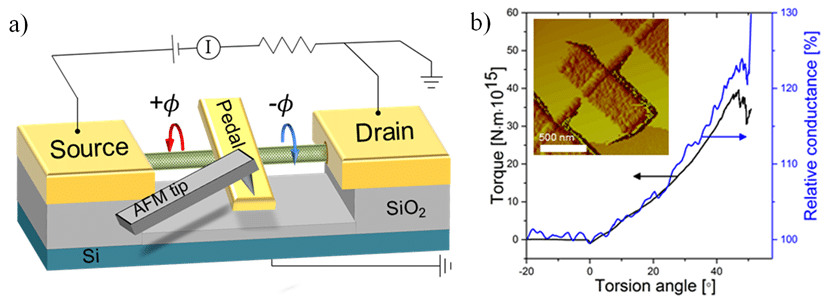
NANOTUBE ELECTROMECHANICS BEYOND CARBON: THE CASE OF WS2
2Theoretische Chemie, Technische Universität Dresden, Dresden
The use of nanostructures such as nanotubes and 2D sheets in electrical and electromechanical devices is the subject of intensive research in recent years. In particular, the electronic properties of inorganic compounds such as the dichlcogenides sparked the research of their incorporation into nano-electro-mechanical systems (NEMS). WS2 nanotubes (INT-WS2) have been shown to exhibit superior mechanical properties and interesting stick-slip mechanical phenomena1 and thus are a natural candidate for electro-mechanical devices.
We show here that INT-WS2 possess significant field-effect mobility and surprisingly high current carrying capacity2. We further present the first demonstration of a significant electro-mechanical response in pure inorganic nanotubes3. The INT-WS2 exhibited a highly repeatable increase of the conductivity in response to strain and/or torsion. These results are in qualitative agreement with the theoretical calculations presented here for torsion and strain. The large sensitivity to torsion and tension suggests INT-WS2 as promising in NEMS such as nano-gyroscopes and accelerometers.

Figure 1. a. Schematics of a WS2 nanotube-based torsional nano-electro-mechanical system (NEMS) and the atomic force microscope (AFM) tip used to perform the torsion. b. INT-WS2-NEMS electrical response to torsion - change in conductivity with the torsion angle. Inset - AFM image of the INT-WS2-NEMS.
References
(1) Nagapriya, K. S.; Goldbart, O.; Kaplan-Ashiri, I.; Seifert, G.; Tenne, R.; Joselevich, E. Physical Review Letters 2008, 101, 195501.
(2) Levi, R.; Bitton, O.; Leitus, G.; Tenne, R.; Joselevich, E. Nano Letters 2013, 13, 3736-3741.
(3) Levi, R.; Garel, J.;Teich, D.; Seifert, G.; Tenne, R.; Joselevich, E. ACS Nano 2015, Article ASAP.
Powered by Eventact EMS